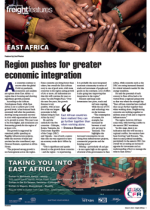Committed to promoting regional trade and economic integration, the East African Community (EAC) has secured US$1.4 million for a feasibility study on a key section of the Northern Transport Corridor linking Kenya and Uganda.According to the EAC deputy secretary general in charge of planning and infrastructure, Steven Mlote, the funding from the African Development Bank will be used to conduct feasibility studies on the 256-kilometre multinational Kisumu-Kisian-Busia/Kakira – Malaba-Busitema -Busia expressway project.The feasibility study will cover the construction of a new road connecting the two countries, as well as the rehabilitation of existing roads and the installation of associated infrastructure. A part of the funding will also be used for the feasibility studies for the upgrading of the Malaba, Busia and Lwakhakha border posts along the Kenya-Uganda border.Providing an alternative routeThe Northern Transport Corridor is a strategic economic corridor between northern Kenya and western Uganda, connecting the three EAC countries of Kenya, Uganda and Tanzania. When completed, it will provide an alternative route for the movement of goods and services between these countries, reducing the cost and time of transport.The corridor will improve access to markets, reduce transport costs, and provide a shorter transit time for goods and services. It is expected to open up new economic opportunities and create jobs in the region.Mlote said the EAC had also secured a commitment of 10 million euros from the Federal Government of Germany in December last year that would be used to finance several other feasibility studies on upgrading trade infrastructure in the region.This is all part of the EAC’s overall strategy of promoting regional economic integration and reducing the cost of doing business in the region.The EAC, he said, was committed to promoting regional trade and economic integration, and the Northern Transport Corridor was an important part of this strategy. “The corridor will create a direct link between the two countries, enabling them to benefit from each other’s economic growth,” he said, indicating that another key priority was to reduce the cost of doing business in the region. Another area the EAC is continuing to improve is mobile connectivity in the region. In 2015 it launched Network Area One (NA1), an initiative to create a single unified telecommunications market in East Africa linking, at the time, Kenya, Uganda, Tanzania, Rwanda and Burundi. Other countries have since joined the project.The EAC maintains that by bridging the digital divide in the region, increasing access to and reducing the cost of communication services, economic development will be promoted.Economies of scaleIt is expected that one of the main drawcards of NA1 is that it will enable the EAC countries to benefit from economies of scale, which will lead to lower costs for consumers and businesses. This will create more opportunities for businesses to expand and create jobs, as well as improve access to services such as banking, education, and healthcare.More recently the EAC Sectoral Council on Transport, Communications and Meteorology (SCTCM) agreed that harmonising mobile and data roaming charges across the region will enhance intra-regional trade.

